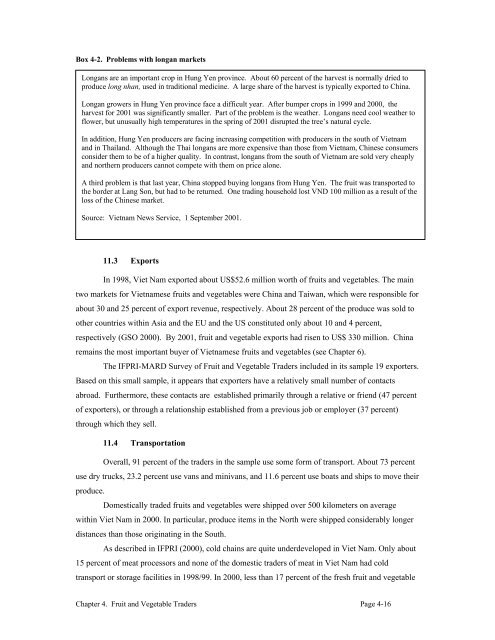Fruits and Vegetables in Vietnam - International Food Policy ...
Fruits and Vegetables in Vietnam - International Food Policy ...
Fruits and Vegetables in Vietnam - International Food Policy ...
You also want an ePaper? Increase the reach of your titles
YUMPU automatically turns print PDFs into web optimized ePapers that Google loves.
Box 4-2. Problems with longan markets<br />
Longans are an important crop <strong>in</strong> Hung Yen prov<strong>in</strong>ce. About 60 percent of the harvest is normally dried to<br />
produce long nhan, used <strong>in</strong> traditional medic<strong>in</strong>e. A large share of the harvest is typically exported to Ch<strong>in</strong>a.<br />
Longan growers <strong>in</strong> Hung Yen prov<strong>in</strong>ce face a difficult year. After bumper crops <strong>in</strong> 1999 <strong>and</strong> 2000, the<br />
harvest for 2001 was significantly smaller. Part of the problem is the weather. Longans need cool weather to<br />
flower, but unusually high temperatures <strong>in</strong> the spr<strong>in</strong>g of 2001 disrupted the tree’s natural cycle.<br />
In addition, Hung Yen producers are fac<strong>in</strong>g <strong>in</strong>creas<strong>in</strong>g competition with producers <strong>in</strong> the south of <strong>Vietnam</strong><br />
<strong>and</strong> <strong>in</strong> Thail<strong>and</strong>. Although the Thai longans are more expensive than those from <strong>Vietnam</strong>, Ch<strong>in</strong>ese consumers<br />
consider them to be of a higher quality. In contrast, longans from the south of <strong>Vietnam</strong> are sold very cheaply<br />
<strong>and</strong> northern producers cannot compete with them on price alone.<br />
A third problem is that last year, Ch<strong>in</strong>a stopped buy<strong>in</strong>g longans from Hung Yen. The fruit was transported to<br />
the border at Lang Son, but had to be returned. One trad<strong>in</strong>g household lost VND 100 million as a result of the<br />
loss of the Ch<strong>in</strong>ese market.<br />
Source: <strong>Vietnam</strong> News Service, 1 September 2001.<br />
11.3 Exports<br />
In 1998, Viet Nam exported about US$52.6 million worth of fruits <strong>and</strong> vegetables. The ma<strong>in</strong><br />
two markets for <strong>Vietnam</strong>ese fruits <strong>and</strong> vegetables were Ch<strong>in</strong>a <strong>and</strong> Taiwan, which were responsible for<br />
about 30 <strong>and</strong> 25 percent of export revenue, respectively. About 28 percent of the produce was sold to<br />
other countries with<strong>in</strong> Asia <strong>and</strong> the EU <strong>and</strong> the US constituted only about 10 <strong>and</strong> 4 percent,<br />
respectively (GSO 2000). By 2001, fruit <strong>and</strong> vegetable exports had risen to US$ 330 million. Ch<strong>in</strong>a<br />
rema<strong>in</strong>s the most important buyer of <strong>Vietnam</strong>ese fruits <strong>and</strong> vegetables (see Chapter 6).<br />
The IFPRI-MARD Survey of Fruit <strong>and</strong> Vegetable Traders <strong>in</strong>cluded <strong>in</strong> its sample 19 exporters.<br />
Based on this small sample, it appears that exporters have a relatively small number of contacts<br />
abroad. Furthermore, these contacts are established primarily through a relative or friend (47 percent<br />
of exporters), or through a relationship established from a previous job or employer (37 percent)<br />
through which they sell.<br />
11.4 Transportation<br />
Overall, 91 percent of the traders <strong>in</strong> the sample use some form of transport. About 73 percent<br />
use dry trucks, 23.2 percent use vans <strong>and</strong> m<strong>in</strong>ivans, <strong>and</strong> 11.6 percent use boats <strong>and</strong> ships to move their<br />
produce.<br />
Domestically traded fruits <strong>and</strong> vegetables were shipped over 500 kilometers on average<br />
with<strong>in</strong> Viet Nam <strong>in</strong> 2000. In particular, produce items <strong>in</strong> the North were shipped considerably longer<br />
distances than those orig<strong>in</strong>at<strong>in</strong>g <strong>in</strong> the South.<br />
As described <strong>in</strong> IFPRI (2000), cold cha<strong>in</strong>s are quite underdeveloped <strong>in</strong> Viet Nam. Only about<br />
15 percent of meat processors <strong>and</strong> none of the domestic traders of meat <strong>in</strong> Viet Nam had cold<br />
transport or storage facilities <strong>in</strong> 1998/99. In 2000, less than 17 percent of the fresh fruit <strong>and</strong> vegetable<br />
Chapter 4. Fruit <strong>and</strong> Vegetable Traders Page 4-16
















